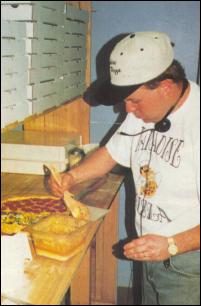Aaron Williams, owner of Paradise Pizza does $1500 a week in sales. Williams said he would like to do more, but in Reader West Virginia, a city of only 800 residents, he is doing as well as anyone could.
The fact that Williams has figured our how to make money and stay in business for five years means that another innovative pizza entreprenuer has made the right set of adjustments to survive in what would seem an impossible business environment.
After all, this is not Boston’s North End or Philadelphia. This is rural West Virginia. Pizza is not all that big in rural West Virginia. However, with pizza’s continued growth in popularity, even places like Reader, West Virginia are providing expansion opportunities for pizza operators.
Williams said there are advantages to being the only pizza within a 15-mile radius. He gets to live in the town he was born in 36 years ago, be close to his family and friends and he doesn’t have to worry about competition.
Owning a pizza store gives me a chance to do two of my favorite things, Williams said, I like serving the community.
Williams said he was always looking for new ways to improve his sales. He even sells pizza to the local school system at a substantial discount.
I sometimes feel like Johnny Appleseed, Williams said. Figuring that I am planting seeds with many of these kids who will eventually be paying customers.
Obviously, it takes a low break even to make a profit at this sales level. This may be where Williams’ degree in accounting may have served him well.
He started off cheap. First, no employees. Second, he bought a used oven and dough-mixer for only $1000 and went from there.
Lessons from Paradise Pizza
- Get wired to a portable phone with headphones. This allows simultaneous order-taking and pizza-making, Williams said. Keep the pizzas orders in your head. No need for cover- your-ass paper work. If a mistake is made, you’ll know who made it.
- Pizzas are par-baked so there is no dough shaping during business hours.
- Cheese is pre-measured in cups to minimize time preparing pizza.
- Use one all-purpose dough for buns, pizza dough and bread sticks.
- Precook your own pizza toppings to save time itemizing.
- Cook pizza at 400 degrees at 10 minutes. There is a little less oven tending involved compared to the average seven minutes. Since his carryout customers do not come in for 15 minutes, it means the pizza will be hotter and fresher for them anyway. The longer bake also gives him a great looking pizza. It’s a pizza with a high rise crust, thanks to a combination of yeast, baking powder and PZ44.













